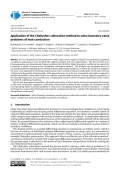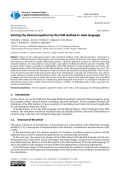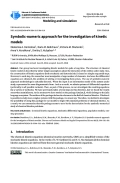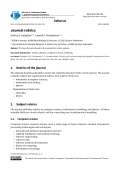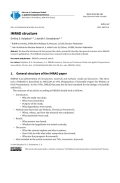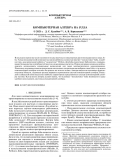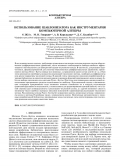For one-dimensional inhomogeneous (with respect to the spatial variable) linear parabolic equations, a combined approach is used, dividing the original problem into two subproblems. The first of them is an inhomogeneous one-dimensional Poisson problem with Dirichlet–Robin boundary conditions, the search for a solution of which is based on the Chebyshev collocation method. The method was developed based on previously published algorithms for solving ordinary differential equations, in which the solution is sought in the form of an expansion in Chebyshev polynomials of the 1st kind on Gauss–Lobatto grids, which allows the use of discrete orthogonality of polynomials. This approach turns out to be very economical and stable compared to traditional methods, which often lead to the solution of poorly defined systems of linear algebraic equations. In the described approach, the successful use of integration matrices allows complete elimination of the need to deal with ill-conditioned matrices.
The second, homogeneous problem of thermal conductivity is solved by the method of separation of variables. In this case, finding the expansion coefficients of the desired solution in the complete set of solutions to the corresponding Sturm–Liouville problem is reduced to calculating integrals of known functions. A simple technique for constructing Chebyshev interpolants of integrands allows to calculate the integrals by summing interpolation coefficients.
There are two main approaches to the numerical solution of the eikonal equation: reducing it to a system of ODES (method of characteristics) and constructing specialized methods for the numerical solution of this equation in the form of a partial differential equation. The latter approach includes the FSM (Fast sweeping method) method. It is reasonable to assume that a specialized method should have greater versatility. The purpose of this work is to evaluate the applicability of the FSM method for constructing beams and fronts. The implementation of the FSM method in the Eikonal library of the Julia programming language was used. The method was used for numerical simulation of spherical lenses by Maxwell, Luneburg and Eaton. These lenses were chosen because their optical properties have been well studied. A special case of flat lenses was chosen as the easiest to visualize and interpret the results. The results of the calculations are presented in the form of images of fronts and rays for each of the lenses. From the analysis of the obtained images, it is concluded that the FSM method is well suited for constructing electromagnetic wave fronts. An attempt to visualize ray trajectories based on the results of his work encounters a number of difficulties and in some cases gives an incorrect visual picture.
We describe the system of ethical disclaimers being introduced in the journal.
Our group has been investigating kinetic models for quite a long time. The structure of classical kinetic models is described by rather simple assumptions about the interaction of the entities under study. Also, the construction of kinetic equations (both stochastic and deterministic) is based on simple sequential steps. However, in each step, the researcher must manipulate a large number of elements. And once the differential equations are obtained, the problem of solving or investigating them arises. The use of symbolic-numeric approach methodology is naturally directed. When the input is an information model of the system under study, represented in some diagrammatic form. And as a result, we obtain systems of differential equations (preferably, in all possible variants). Then, as part of this process, we can investigate the resulting equations (by a variety of methods). We have previously taken several steps in this direction, but we found the results somewhat unsatisfactory. At the moment we have settled on the package Catalyst. jl, which belongs to the Julia language ecosystem. The authors of the package declare its relevance to the field of chemical kinetics. Whether it is possible to study more complex systems with this package, we cannot say. Therefore, we decided to investigate the possibility of using this package for our models to begin with standard problems of chemical kinetics. As a result, we can summarize that this package seems to us to be the best solution for the symbolic-numerical study of chemical kinetics problems.
We describe introduced in the journal the rubric system.
We describe introduced in the journal the rubric system. We describe the general structure of an IMRAD research publication. The IMRAD structure for a research article is described in detail.
В последнее время на место основного языка научных и инженерных расчетов выдвигается язык Julia. У ряда пользователей возникает желание работать полностью внутри “экосистемы” Julia, подобно тому, как происходит работа в “экосистеме” Python. Для Julia существуют библиотеки, покрывающие большинство потребностей научно-инженерных расчетов. Перед авторами возникла необходимость использовать символьные вычисления для задач математического моделирования. Поскольку основным языком реализации численных алгоритмов мы выбрали язык Julia, то и задачи компьютерной алгебры хотелось бы решать на этом же языке. Авторы выделили основные функциональные области, задающие разные варианты применения систем компьютерной алгебры. В каждой из областей нами выделены наиболее характерные представители систем компьютерной алгебры на Julia. В результате авторы делают вывод, что в рамках “экосистемы” Julia возможно (и даже удобно) использовать системы компьютерной алгебры.
В исследовательских задачах, требующих применения численных методов решения систем обыкновенных дифференциальных уравнений, часто возникает необходимость выбора наиболее эффективного и оптимального для конкретной задачи численного метода. В частности, для решения задачи Коши, сформулированной для системы обыкновенных дифференциальных уравнений, применяются методы Рунге–Кутты (явные или неявные, с управлением шагом сетки или без и т.д.). При этом приходится перебирать множество реализаций численного метода, подбирать коэффициенты или другие параметры численной схемы. В данной статье предложено описание разработанной авторами библиотеки и скриптов автоматизации генерации функций программного кода на языке Julia для набора численных схем методов Рунге–Кутты. При этом для символьных манипуляций использовано программное средство подстановки по шаблону. Предлагаемый подход к автоматизации генерации программного кода позволяет вносить изменения не в каждую подлежащую сравнению функцию по отдельности, а использовать для редактирования единый шаблон, что с одной стороны дает универсальность в реализации численной схемы, а с другой позволяет свести к минимуму число ошибок в процессе внесения изменений в сравниваемые реализации численного метода. Рассмотрены методы Рунге–Кутты без управления шагом, вложенные методы с управлением шагом и методы Розенброка также с управлением шагом. Полученные автоматически с помощью разработанной библиотеки программные коды численных схем протестированы при численном решении нескольких известных задач.
